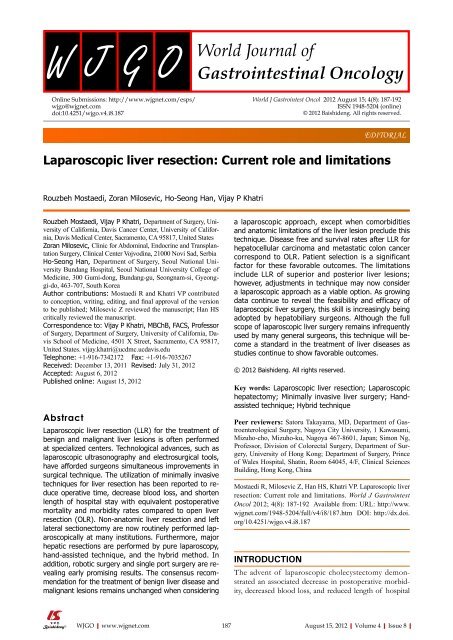Gastrointestinal Oncology - World Journal of Gastroenterology
Gastrointestinal Oncology - World Journal of Gastroenterology
Gastrointestinal Oncology - World Journal of Gastroenterology
Create successful ePaper yourself
Turn your PDF publications into a flip-book with our unique Google optimized e-Paper software.
Online Submissions: http://www.wjgnet.com/esps/<br />
wjgo@wjgnet.com<br />
doi:10.4251/wjgo.v4.i8.187<br />
Laparoscopic liver resection: Current role and limitations<br />
Rouzbeh Mostaedi, Zoran Milosevic, Ho-Seong Han, Vijay P Khatri<br />
Rouzbeh Mostaedi, Vijay P Khatri, Department <strong>of</strong> Surgery, University<br />
<strong>of</strong> California, Davis Cancer Center, University <strong>of</strong> California,<br />
Davis Medical Center, Sacramento, CA 95817, United States<br />
Zoran Milosevic, Clinic for Abdominal, Endocrine and Transplantation<br />
Surgery, Clinical Center Vojvodina, 21000 Novi Sad, Serbia<br />
Ho-Seong Han, Department <strong>of</strong> Surgery, Seoul National University<br />
Bundang Hospital, Seoul National University College <strong>of</strong><br />
Medicine, 300 Gumi-dong, Bundang-gu, Seongnam-si, Gyeonggi-do,<br />
463-707, South Korea<br />
Author contributions: Mostaedi R and Khatri VP contributed<br />
to conception, writing, editing, and final approval <strong>of</strong> the version<br />
to be published; Milosevic Z reviewed the manuscript; Han HS<br />
critically reviewed the manuscript.<br />
Correspondence to: Vijay P Khatri, MBChB, FACS, Pr<strong>of</strong>essor<br />
<strong>of</strong> Surgery, Department <strong>of</strong> Surgery, University <strong>of</strong> California, Davis<br />
School <strong>of</strong> Medicine, 4501 X Street, Sacramento, CA 95817,<br />
United States. vijay.khatri@ucdmc.ucdavis.edu<br />
Telephone: +1-916-7342172 Fax: +1-916-7035267<br />
Received: December 13, 2011 Revised: July 31, 2012<br />
Accepted: August 6, 2012<br />
Published online: August 15, 2012<br />
Abstract<br />
Laparoscopic liver resection (LLR) for the treatment <strong>of</strong><br />
benign and malignant liver lesions is <strong>of</strong>ten performed<br />
at specialized centers. Technological advances, such as<br />
laparoscopic ultrasonography and electrosurgical tools,<br />
have afforded surgeons simultaneous improvements in<br />
surgical technique. The utilization <strong>of</strong> minimally invasive<br />
techniques for liver resection has been reported to reduce<br />
operative time, decrease blood loss, and shorten<br />
length <strong>of</strong> hospital stay with equivalent postoperative<br />
mortality and morbidity rates compared to open liver<br />
resection (OLR). Non-anatomic liver resection and left<br />
lateral sectionectomy are now routinely performed laparoscopically<br />
at many institutions. Furthermore, major<br />
hepatic resections are performed by pure laparoscopy,<br />
hand-assisted technique, and the hybrid method. In<br />
addition, robotic surgery and single port surgery are revealing<br />
early promising results. The consensus recommendation<br />
for the treatment <strong>of</strong> benign liver disease and<br />
malignant lesions remains unchanged when considering<br />
<strong>World</strong> J Gastrointest Oncol 2012 August 15; 4(8): 187-192<br />
ISSN 1948-5204 (online)<br />
© 2012 Baishideng. All rights reserved.<br />
a laparoscopic approach, except when comorbidities<br />
and anatomic limitations <strong>of</strong> the liver lesion preclude this<br />
technique. Disease free and survival rates after LLR for<br />
hepatocellular carcinoma and metastatic colon cancer<br />
correspond to OLR. Patient selection is a significant<br />
factor for these favorable outcomes. The limitations<br />
include LLR <strong>of</strong> superior and posterior liver lesions;<br />
however, adjustments in technique may now consider<br />
a laparoscopic approach as a viable option. As growing<br />
data continue to reveal the feasibility and efficacy <strong>of</strong><br />
laparoscopic liver surgery, this skill is increasingly being<br />
adopted by hepatobiliary surgeons. Although the full<br />
scope <strong>of</strong> laparoscopic liver surgery remains infrequently<br />
used by many general surgeons, this technique will become<br />
a standard in the treatment <strong>of</strong> liver diseases as<br />
studies continue to show favorable outcomes.<br />
© 2012 Baishideng. All rights reserved.<br />
Key words: Laparoscopic liver resection; Laparoscopic<br />
hepatectomy; Minimally invasive liver surgery; Handassisted<br />
technique; Hybrid technique<br />
Peer reviewers: Satoru Takayama, MD, Department <strong>of</strong> Gastroenterological<br />
Surgery, Nagoya City University, 1 Kawasumi,<br />
Mizuho-cho, Mizuho-ku, Nagoya 467-8601, Japan; Simon Ng,<br />
Pr<strong>of</strong>essor, Division <strong>of</strong> Colorectal Surgery, Department <strong>of</strong> Surgery,<br />
University <strong>of</strong> Hong Kong; Department <strong>of</strong> Surgery, Prince<br />
<strong>of</strong> Wales Hospital, Shatin, Room 64045, 4/F, Clinical Sciences<br />
Building, Hong Kong, China<br />
Mostaedi R, Milosevic Z, Han HS, Khatri VP. Laparoscopic liver<br />
resection: Current role and limitations. <strong>World</strong> J Gastrointest<br />
Oncol 2012; 4(8): 187-192 Available from: URL: http://www.<br />
wjgnet.com/1948-5204/full/v4/i8/187.htm DOI: http://dx.doi.<br />
org/10.4251/wjgo.v4.i8.187<br />
INTRODUCTION<br />
EDITORIAL<br />
The advent <strong>of</strong> laparoscopic cholecystectomy demonstrated<br />
an associated decrease in postoperative morbidity,<br />
decreased blood loss, and reduced length <strong>of</strong> hospital<br />
WJGO|www.wjgnet.com 187<br />
August 15, 2012|Volume 4|Issue 8|

















